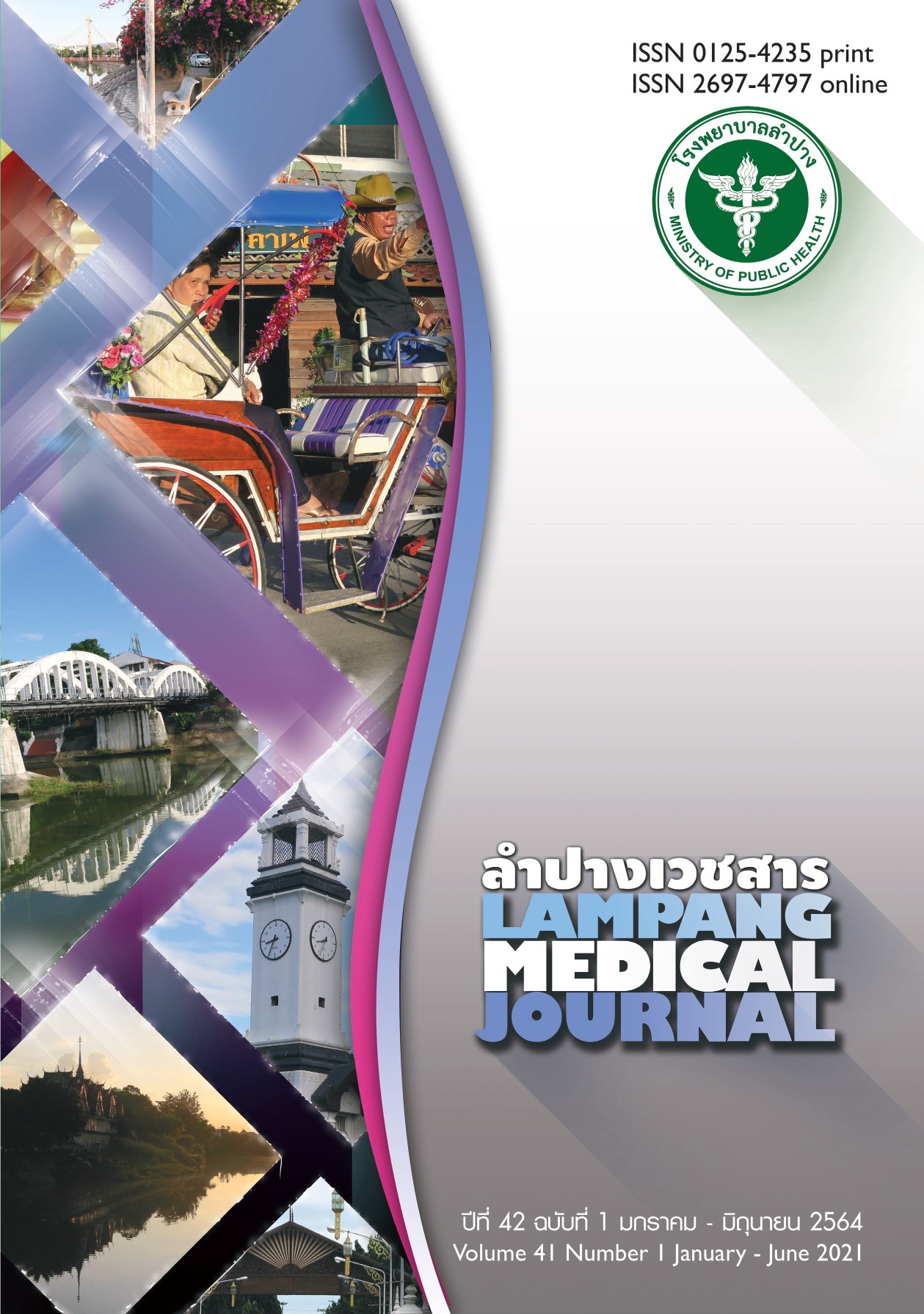Results of Penetrating Keratoplasty in Phrae Hospital
Main Article Content
Abstract
Background: Penetrating keratoplasty (PKP) is a surgery for blindness from corneal diseases. Results of PKP in Phrae Hospital have not been studied.
Objective: To determine the results of PKP in Phrae Hospital using corneal cutting techniques by manual and vacuum trephines.
Material and method: A retrospective cohort study was conducted among patients with corneal diseases who underwent optical PKP in Phrae Hospital by single ophthalmologist. Patients in group 1 underwent
surgery during 2007 – 2010, using manual trephine for corneal cutting and donor corneas from the local donation campaign. Group 2 underwent surgery during 2018 – 2019, cutting cornea by vacuum trephine and
receiving donor cornea from the Thai Red Cross Eye Bank and local donation campaign. The follow-up period was at least one year. Visual outcomes and complications were compared between groups using
Mann-Whitney U test and Fisher’s exact test.
Results: PKPs were performed in 19 eyes of 17 patients (1 case bilaterally, 1 case redo surgery) and nine cases were male. The mean age was 66.2 (SD 10.9) years (range 42–80). Herpes simplex keratitis was
the most common disease. Group 1 (8 eyes) underwent PKP in 5, triple operation in 2 and PKP with scleral-fix IOL in 1 eye respectively. Group 2 (11 eyes) underwent triple operation in 6, PKP in 4 and PKP with IOL
exchange in 1 eye respectively. Most of the patients had postoperative visual acuity at 6/24 – 6/60. Seven eyes in group 1 and eight eyes in group 2 had better visual outcomes (p=0.426). Regarding to the remaining
clear corneal grafts postoperatively, the success rate was 75% in group 1 at 2-year and 72.7% in group 2 at 1-year follow-up (p=0.664). Most of complications were astigmatism (6 vs 5 eyes in group 1 and 2 respectively,
(p=0.208), glaucoma (5 eyes) and graft failure (3 eyes).
Conclusion: The success rate of PKP in Phrae Hospital was 73.7%. Most of the patients had better visual outcomes. Herpes simplex keratitis was the most common etiology. The major complication was astigmatism
which more commonly found in cases using manual trephine.
Article Details
บทความที่ส่งมาลงพิมพ์ต้องไม่เคยพิมพ์หรือกำลังได้รับการพิจารณาตีพิมพ์ในวารสารอื่น เนื้อหาในบทความต้องเป็นผลงานของผู้นิพนธ์เอง ไม่ได้ลอกเลียนหรือตัดทอนจากบทความอื่น โดยไม่ได้รับอนุญาตหรือไม่ได้อ้างอิงอย่างเหมาะสม การแก้ไขหรือให้ข้อมูลเพิ่มเติมแก่กองบรรณาธิการ จะต้องเสร็จสิ้นเป็นที่เรียบร้อยก่อนจะได้รับพิจารณาตีพิมพ์ และบทความที่ตีพิมพ์แล้วเป็นสมบัติ ของลำปางเวชสาร
References
สำนักงานปลัดกระทรวงสาธารณสุข, สำนักบริหารสาธารณสุข, คณะกรรมการพัฒนาระบบบริการที่ตอบสนองต่อปัญหาสุขภาพที่สำคัญ (สาขาจักษุ). แนวทางพัฒนาระบบบริการสุขภาพสาขาจักษุวิทยา. กรุงเทพฯ: โรงพิมพ์ชุมนุมสหกรณ์การเกษตรแห่งประเทศไทย; 2556.
Prabhasawat P, Trethipwanit K, Prakairungthong N, Narenpitak S, Jaruroteskulchai S, Anantachai J. Causes of corneal blindness: a multi-center retrospective review. J Med Assoc Thai. 2007;90(12):2651–7.
Ornsiri T. Moving towards eye center of excellence. Srinagarind Med J. 2013;28 Suppl:144–6.
Eye Bank Association of America. Statistical report 2018. [cited 2019 May 18]. Available from: https://
restoresight.org/whatwe- do/publications/statistical-report/
Waldock A, Cook JD. Corneal transplantation: how successful are we?. Br J Ophthalmol. 2000;84
(8):813–5.
Thompson RW Jr, Price MO, Bowers PJ, Price FW Jr. Long-term graft survival after penetrating keratoplasty. Ophthalmology. 2003;110(7): 1396–402.
Chaiear S. Indications and visual results of penetrating keratoplasty in Udonthani Hospital between 1997 and 2006: a retrospective review of 84 cases. Srinagarind Med J. 2008;23:207–14.
Ahmad S, Klawe J, Utine CA, Srikumaran D, Jimenez J, Akpek E. Survival of penetrating keratoplasty: a claims-based longitudinal analysis. Can J Ophthalmol. 2021;56(1):12–6.
Anshu A, Li L, Htoon HM, de Benito-Llopis L, Shuang LS, Singh MJ, et al. Long-term review of penetrating keratoplasty: a 20-year review in Asian eyes. Am J Ophthalmol. 2021;224;254-66.
Isipradit S, Roongpoovapatr V. Outcomes of therapeutic penetrating keratoplasty in a tertiary care hospital in Thailand. Thai J Ophthalmology. 2019;33(1):27–39.
Tangpagasit W, Reanpinyawat T. Outcome of urgent penetrating keratoplasty for corneal ulcer at Thammasat University Hospital. J Med Assoc Thai. 2016;99(1):71–6.
Sugar A, Tanner JP, Dontchev M, Tennant B, Schultze RL, Dunn SP, et al. Recipient risk factors for graft failure in the cornea donor study. Ophthalmology. 2009;116(6):1023–8.
Halberstadt M, Machens M, Gahlenbek KA, Böhnke M, Garweg JG. The outcome of corneal grafting in patients with stromal keratitis of herpetic and non-herpetic origin. Br J Ophthalmol. 2002;86(6):646–52.
Chan CC, Perez MA, Verdier DD, Van Meter WS. Penetrating keratoplasty: the fundamentals. In: Mannis MJ, Holland EJ, editors. Cornea. 4th ed. Philadelphia: Elsevier; 2017. P. 1264–76.
Seitz B, Langenbucher A, Naumann GOH. Trephination in penetrating keratoplasty. In: Reinhard T, Larkin F, editors. Cornea and external eye disease. Berlin: Springer; 2006. P.123–52.
Kim SJ, Wee WR, Lee JH, Kim MK. The effect of different suturing techniques on astigmatism after penetrating keratoplasty. J Korean Med Sci. 2008;23(6):1015–9
Baltaziak M, Chew HF, Podbielski DW, Ahmed IIK. Glaucoma after corneal replacement. Surv Ophthalmol. 2018;63(2):135–48.
Wagoner MD, Al-Swailem SA, Sutphin JE, Zimmerman MB. Bacterial keratitis after penetrating keratoplasty incidence, microbiological profile, graft survival, and visual outcome. Ophthalmology. 2007;114(6):1073–9.
Huang SC, Wu SC, Wu WC, Hong HL. Microbial keratitis - a late complication of penetrating keratoplasty. Trans R Soc Trop Med Hyg. 2000;94(3):315–7.
Bidaut-Garnier M, Monnet E, Prongue A, Montard R, Gauthier AS, Desmarets M, et al. Evolution of corneal graft survival over a 30-year period and comparison of surgical techniques: a cohort study. Am J Ophthalmol. 2016;163:59–69.
Guilbert E, Bullet J, Sandali O, Basli E, Laroche L, Borderie VM. Long-term rejection incidence and reversibility after penetrating and lamellar keratoplasty. Am J Ophthalmol. 2013;155(3):560–9.
Moyes AL, Sugar A, Musch DC, Barnes RD. Antiviral therapy after penetrating keratoplasty for herpes simplex keratitis. Arch Ophthalmol. 1994;112(5):601–7.
Le Q, Xu J, Deng SX. The diagnosis of limbal stem cell deficiency. Ocul Surf. 2018;16(1):58–69.


